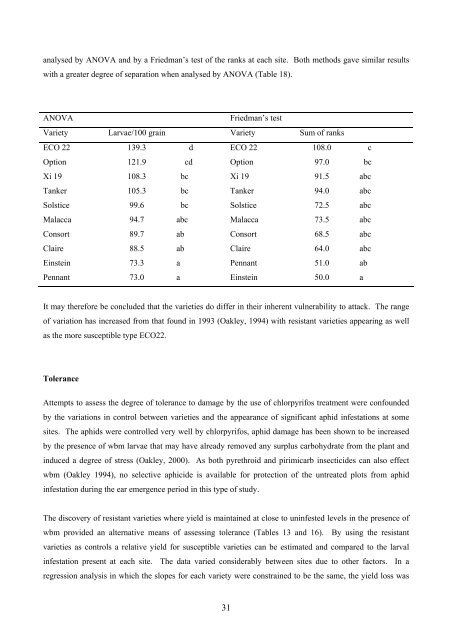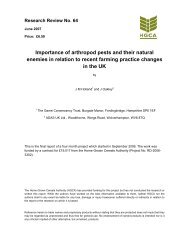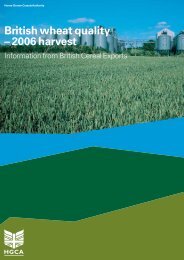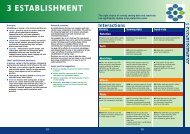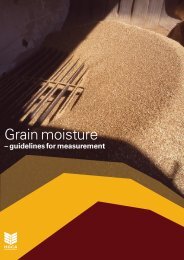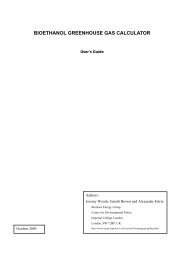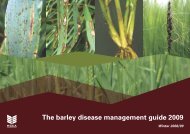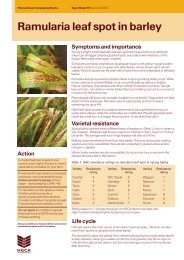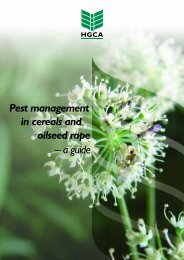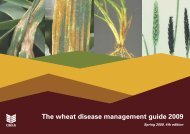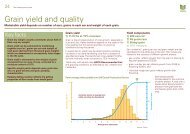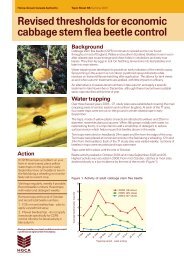Integrated control of wheat blossom midge - HGCA
Integrated control of wheat blossom midge - HGCA
Integrated control of wheat blossom midge - HGCA
Create successful ePaper yourself
Turn your PDF publications into a flip-book with our unique Google optimized e-Paper software.
analysed by ANOVA and by a Friedman’s test <strong>of</strong> the ranks at each site. Both methods gave similar resultswith a greater degree <strong>of</strong> separation when analysed by ANOVA (Table 18).ANOVAFriedman’s testVariety Larvae/100 grain Variety Sum <strong>of</strong> ranksECO 22 139.3 d ECO 22 108.0 cOption 121.9 cd Option 97.0 bcXi 19 108.3 bc Xi 19 91.5 abcTanker 105.3 bc Tanker 94.0 abcSolstice 99.6 bc Solstice 72.5 abcMalacca 94.7 abc Malacca 73.5 abcConsort 89.7 ab Consort 68.5 abcClaire 88.5 ab Claire 64.0 abcEinstein 73.3 a Pennant 51.0 abPennant 73.0 a Einstein 50.0 aIt may therefore be concluded that the varieties do differ in their inherent vulnerability to attack. The range<strong>of</strong> variation has increased from that found in 1993 (Oakley, 1994) with resistant varieties appearing as wellas the more susceptible type ECO22.ToleranceAttempts to assess the degree <strong>of</strong> tolerance to damage by the use <strong>of</strong> chlorpyrifos treatment were confoundedby the variations in <strong>control</strong> between varieties and the appearance <strong>of</strong> significant aphid infestations at somesites. The aphids were <strong>control</strong>led very well by chlorpyrifos, aphid damage has been shown to be increasedby the presence <strong>of</strong> wbm larvae that may have already removed any surplus carbohydrate from the plant andinduced a degree <strong>of</strong> stress (Oakley, 2000). As both pyrethroid and pirimicarb insecticides can also effectwbm (Oakley 1994), no selective aphicide is available for protection <strong>of</strong> the untreated plots from aphidinfestation during the ear emergence period in this type <strong>of</strong> study.The discovery <strong>of</strong> resistant varieties where yield is maintained at close to uninfested levels in the presence <strong>of</strong>wbm provided an alternative means <strong>of</strong> assessing tolerance (Tables 13 and 16). By using the resistantvarieties as <strong>control</strong>s a relative yield for susceptible varieties can be estimated and compared to the larvalinfestation present at each site. The data varied considerably between sites due to other factors. In aregression analysis in which the slopes for each variety were constrained to be the same, the yield loss was31


